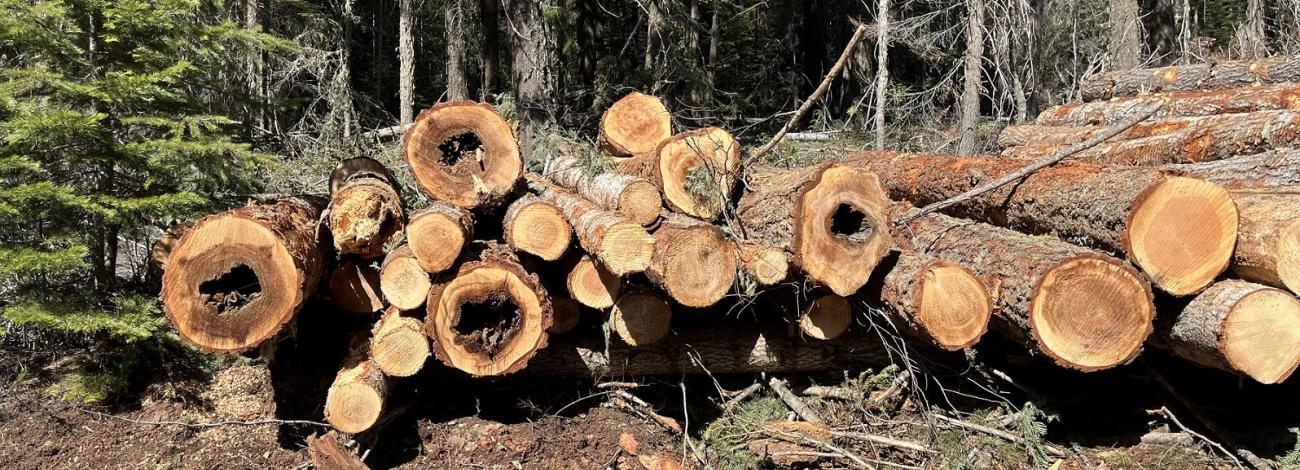
CSNM Hazard Tree Removal
In the interest of public safety, the Bureau of Land Management is removing dead and dying trees that pose imminent risks within Cascade-Siskiyou National Monument. The work is focused along specific roads and around the Hyatt Lake Campground.
Our goal is to let you know what we are doing and why.
Background
Decades of extreme fire suppression, prolonged drought, climate change, and periods of high temperatures are stressing trees in southwest Oregon. Based on aerial survey data, more trees died in the four-year period from 2015 to 2019 than in the previous four decades. More recent surveys have shown exponential growth in mortality in 2022.
What is a “Hazard Tree”?
Hazard trees pose potential dangers to Monument visitors and staff. Hazard trees are dead or dying and have a high risk of falling within the next few seasons. Within Cascade-Siskiyou National Monument, hazard tree mitigation is focused along major roads used for ingress/egress, utility line corridors, structures, and around other infrastructure (such as Hyatt Lake Campground). There are over 800 miles of roads in the Monument; there is currently no plan to do this work along every mile of road.
Highly trained BLM natural resource specialists are responsible for identifying and marking the hazard trees. They base their identification on the Field Guide for Danger-Tree Identification and Response along Forest Roads and Work Sites in Oregon and Washington.
In some cases, trees still have green needles and can appear alive to the casual observer. BLM specialists look for more subtle clues, like a thinning crown, pitch jewels, and increased pinecone crop.
Where is the BLM working?
We are prioritizing our work in locations where falling trees are likely to cause safety issues to the recreating public, like Hyatt Lake Campground. Additionally, roadside hazard tree removal is critical for providing ingress and egress to residents, visitors and first responders, especially as fire season approaches.
In March 2024, BLM contracted hazard tree removal along 1/3 mile section of Chinquapin Road, and work was also conducted along Emigrant Creek Road. In addition to securing access for residents and emergency responders the Emigrant Creek Road hazard tree removal is necessary prior to planned resurfacing operations this year.
Notification of future projects will happen on this page.
What do the Proclamation and Resource Management Plan say about how to address hazard trees within the Monument?
The BLM manages the Monument based on the presidential proclamations that established it and its governing resource management plans. Presidential Proclamation 7318 recognized the importance of public safety, stating “Removal of trees from within the monument area may take place only if clearly needed for ecological restoration and maintenance or public safety.”
Accordingly, the 2008 CSNM RMP/ROD includes the following direction:
“Road maintenance includes removing safety hazards…Safety hazards include trees that have potential to fall on structures, recreation areas, or roadways” (p. 84); and
“Removal of trees from within the monument may take place only if clearly needed for ecological restoration, authorized facility maintenance, or public safety. The felling of trees may occur where select trees endanger facilities, visitors, or public safety. Such situations are anticipated along roads, utility rights-of-ways, communication sites, trails, property lines, parking areas, and campgrounds and high visitor-use areas within the Hyatt Lake Recreation Complex.” (p. 112).
How is BLM completing NEPA for these projects?
The BLM carefully evaluates all projects within CSNM for protection of Monument resources as well as compliance with the RMP/ROD. This hazard tree mitigation work was covered in the Proposed Salvage of Individual or Small Groups Trees for Safety, Calendar Years 2021-2026, in accordance with 43 CFR 46.210 BLM categorical exclusion C (2) as follows:
“Sale and removal of individual trees, or small groups of trees which are dead, diseased, injured, or which constitute a safety hazard, and where access for removal requires no more than maintenance to existing road.”
During the review process for the categorical exclusion, members of the interdisciplinary team evaluated the potential impacts of these types of hazard tree mitigation actions and determined the following: “Activities may occur within Wild & Scenic River corridors, CSNM, Areas of Critical Environmental Concern, and other ecologically significant or critical areas… while there will be beneficial impacts related to safety, the limited extent of this project and by including appropriate project design features, there will be no significant impacts on the resources which these designations are intended to protect.”
Highly trained resource specialists then review specific projects covered by this CX to ensure there will be no site-specific impacts to monument objects and values.
Why is the BLM using a timber sale contract?
In order to complete this important safety work in an efficient and cost-effective way, we rely on negotiated timber sale contracts.
The trees do not count towards the BLM Medford Districts timber targets. Timber sale contracts are used to get the trees cut and removed in a cost-effective manner. Other, non-sale options for doing this work would be significantly more expensive to the American taxpayer. Removing the trees after they are completely dead and have lost all commercial value is cost prohibitive while creating additional safety risks for workers and visitors.
The contract mechanism for the roadside hazard tree treatment is the Vegetative Material Negotiated Cash Sale Contract, Form 5450-5. This type of contract is made without formal publication and posting of notice of sale, and without use of competitive bidding procedures.
Contact
For additional information about hazard tree removal, or to report a problem area, please contact Lauren Brown, Ashland Field Manager, at [email protected] or 541-618-2232.
